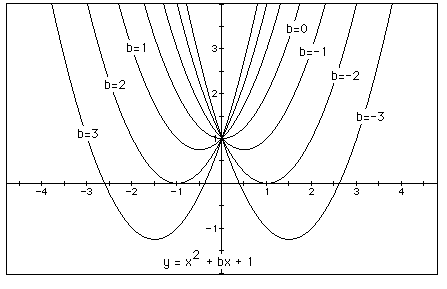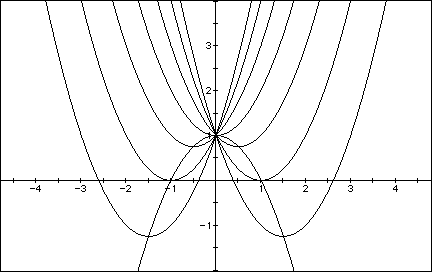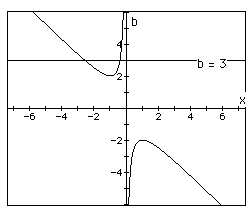It has now become a rather standard exercise, with availble technology,
to construct graphs to consider the equation
and to overlay several graphs of
for different values of a, b, or c as the other two are held constant.
From these graphs discussion of the patterns for the roots of
can be followed. For example, if we set
for b = -3, -2, -1, 0, 1, 2, 3, and overlay the graphs, the following
picture is obtained.

We can discuss the "movement" of a parabola as b is changed.
The parabola always passes through the same point on the y-axis ( the point
(0,1) with this equation). For b < -2 the parabola will intersect the
x-axis in two points with positive x values (i.e. the original equation
will have two real roots, both positive). For b = -2, the parabola is tangent
to the x-axis and so the original equation has one real and positive root
at the point of tangency. For -2 < b < 2, the parabola does not intersect
the x-axis -- the original equation has no real roots. Similarly for b =
2 the parabola is tangent to the x-axis (one real negative root) and for
b > 2, the parabola intersets the x-axis twice to show two negative real
roots for each b.
If we complete the square on the equation

we can find the coordintates of the vertex as a function of a, b and
c. The equation that we graphed above has values of a=1, and c=1. The coordinates
of the vertex depend upon the value that we choose for b, and they are

in general when a=c=1. Let us examine the locus of the vertex as b varies.
When the vertices are connected for different values of b, the resulting
shape suggests that the locus of the vertices is a parabola. If that is
the case, then the coordinates of the vertices must satisfy a general equation
for a parabola. If we start with the general equation of a parabola and
substitute the coordinates of the vertex, the resulting equation can be
simplified.

If we are only varying b, then a, c, d, e and f can be considered constants.
In order for each side of the equation to be equal, the terms for each degree
of b must be equal. By comparing terms of the same degree of b, we can solve
for d, e and f in terms of a and c.

The general equation of the locus of the vertices is the following equation.
If we consider the case that we have been working with where a=1, and
c=1, the equation of the locus of the verteices is
Let us graph this parabola to check to make sure that it is the locus
of vertices.

Consider again the equation
If we take any particular value of b, say b = 3, and overlay this equation
on the graph of the relation, we add a line parallel to the x-axis. If it
intersects the curve in the xb plane the intersection points correspond
to the roots of the original equation for that value of b. We have the following
graph.

For each value of b we select, we get a horizontal line. It is clear
on a single graph that we get two negative real roots of the original equation
when b > 2, one negative real root when b = 2, no real roots for -2 <
b < 2, One positive real root when b = -2, and two positive real roots
when b < -2.
When we consider the equation
the graph that we get is different from the preceding graph.

No matter what value of b that we choose, there will always be two real
roots. One root will always be positive, and the other root will always
be negative.
Let us examine what happens in the xc plane. In the following example the
equation
is considered. When the equation is graphed in the xc plane, it is easy
to see that the curve will be a parabola. For each value of c considered,
its graph will be a line crossing the parabola in 0, 1, or 2 points -- the
intersections being at the roots of the orignal equation at that value of
c. In the graph, the graph of c = 1 is shown. The equation
will have two negative roots -- approximately -0.2 and -4.8.

The value of c where the equation will have only 1 real root is at c
= 6.25. For c >6.25 the equation will have no real roots and for c <
6.25 the equation will have two roots, both negative for 0 < c < 6.25,
one negative and one 0 when c = 0 and one negative and one positive when
c < 0.
If we consider the equation
and graph it in the xa plane, we get the following graph.

If a >1, there will no real roots, while if 0 < a < 1 there
will be two negative real roots. If a = 1 or a = 0 then there will be one
real root, while if a < 0 then there will be two real roots, one positive
and one negative. While c is positive, the possibilities for the roots of
the equation will be no real roots, two values where there will be one real
root, two negative roots or a negative and a positive root. If c is negative,
the possibilities for the roots will be no real roots, two values where
there will be one real root, two positive roots or a negative and a positive
root.